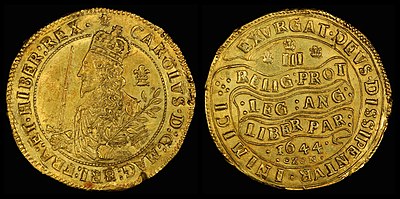| This article does not cite any sources. Please help improve this article by adding citations to reliable sources. Unsourced material may be challenged and removed. Find sources: "Triple Unite" English coin – news · newspapers · books · scholar · JSTOR (December 2009) (Learn how and when to remove this message) |
 1644 Triple Unite (obverse)
1644 Triple Unite (obverse)
 1644 Triple Unite (reverse)
1644 Triple Unite (reverse)
The Triple Unite, valued at sixty shillings, 60/- or three pounds, was the highest English denomination to be produced in the era of the hammered coinage. It was only produced during the English Civil War, at King Charles I's mints at Oxford (between 1642 and 1644) and, rarely, at Shrewsbury in 1642. It weighed 421 grains (27.3 grams, or just over seven-eighths of a troy ounce).
The gold coins show the king holding a sword and an olive branch on the obverse, signifying his wish for peace rather than war.
The extremely rare Shrewsbury-produced coin shows, on the obverse, a plume behind the kings' head surrounded by the legend CAROLUS DG MAG BRIT FRAN ET HIBER REX – Charles by the grace of God King of Great Britain France and Ireland. The reverse shows the legend RELIG PROT LEG ANG LIBER PAR in three lines – The religion of the Protestants, the laws of England and the liberty of Parliament, with three plumes and the value numeral III above the declaration and the year 1642 below it, the whole being surrounded by the legend EXURGAT DEUS DISSIPENTUR INIMICI ("Let God arise and His enemies be scattered", from Psalm 68).
The Oxford issues are very similar to the Shrewsbury one, except that the legend on the reverse appears in three lines rather than two, and the obverse legend appears as CAROLUS DG MAG BRIT FR ET HIB REX. Oxford coins appear with slight design differences in each year of 1642, 1643, and 1644.
External links
- Triple Unite Sales Archive – A gallery of Triple Unite pictures, varieties and values.
| Coins of England | ||
|---|---|---|
| Silver |  | |
| Gold |
| |
| Copper and tin | ||
| Coins of England category | ||